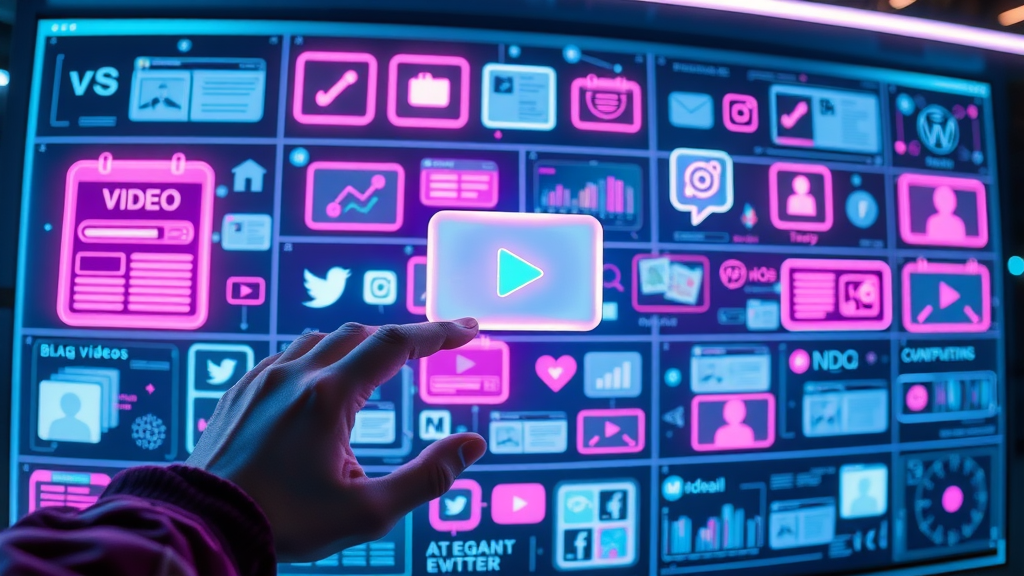Did you know? Over 70% of consumers now prefer discovering brands through digital content rather than traditional ads. This remarkable shift makes mastering digital content creation not just an advantage—it’s a necessity. Whether you’re a new content creator or an established digital strategist, the time to up your content game is now. In this guide, you’ll unveil clever shortcuts, expert-backed tips, and proven systems all designed to help you create digital content faster, smarter, and with more impact—no more waiting for inspiration or wasting hours on repetitive tasks.
- Why digital content creation is more important (and valuable) than ever
- Proven, actionable time-saving tips
- Step-by-step content creation process breakdowns
- The essential tools and strategies for every content creator
- Real-world case studies, expert quotes, and FAQs
Why You Can’t Ignore digital content creation: Surprising Data and Fast Facts
Digital content creation is no longer just a buzzword in marketing—it's the backbone of modern communication. With consumers spending more than 6 hours per day engaging with digital content on media platforms , the race to grab and hold audience attention has never been hotter. Today’s digital content spans everything from informative blog posts to captivating video content and viral media posts, each offering unique ways to connect with your target audience . Ignoring digital content means missing out on prime opportunities to influence potential customers and stay ahead in the increasingly competitive digital market.
For content creators and businesses alike, failing to invest in a robust digital content strategy can result in diminished visibility and lost revenue. In fact, research shows that brands with consistent, high-quality content creation processes outperform those that rely on sporadic, ad-hoc postings. From boosting brand authority to generating leads through social media posts or a well-optimized blog post, a reliable approach to digital content creation supports everything from search engine performance to customer trust and retention.
"Over 70% of consumers prefer to learn about brands through digital content over traditional ads—a powerful shift prompting fresh strategies for content creators."

Mastering digital content creation: Essential Skills and Obligations for Modern content creators
Becoming a successful content creator in today’s digital landscape means blending creative flair with strategic discipline. At its core, digital content creation demands an understanding of diverse digital content formats , from written blog posts and infographics to media posts and social videos. Every step—from ideation to publication—requires tailored skills, whether you’re designing images, crafting compelling copy, or scheduling multi-platform campaigns. Mastery of these skills ensures that each piece of content aligns with a broader content strategy and resonates with the target audience .
Modern content creators must also stay updated on tools, trends, and best practices to remain competitive. Consistency in the content creation process is critical: a steady output, clear brand voice, and ongoing content optimization can set a creator apart from the noise. Additionally, analyzing engagement data and audience feedback ensures you’re not just creating content, but building meaningful connections.
- Strong content strategy alignment
- Understanding of digital content formats
- Ability to engage a targeted audience
- Consistency in the content creation process
| Role | Common Tools | Skills Needed |
|---|---|---|
| Content Creator | Canva, Adobe Creative | Design, Writing |
| Social Media Manager | Buffer, Hootsuite | Analytics, Scheduling |
| Blogger | WordPress, Grammarly | SEO, Storytelling |
The digital content creation Process: Step-by-Step Breakdown
Creating impactful digital content requires more than inspiration—it’s a repeatable creation process . A clearly outlined digital content creation process ensures you never miss crucial steps, from identifying your target audience to perfecting your final blog post or video content. Start by analyzing your desired audience’s demographics and psychographics, then move on to researching what resonates with them, taking cues from current digital marketing trends. Next, design a strategy tailored to your audience’s needs across key media platforms.
With planning in place, execute your ideas through content production—drafting scripts, designing visuals, or shooting videos, depending on the type of content. Maintain organization with editorial calendars, task boards, and documentation of content formats. Finally, review and polish your content, optimizing it for platforms or search engine performance, and distribute it through the proper channels, from media accounts to email newsletters.
- Identifying your target audience
- Designing effective content strategy
- Researching trends and best practices for digital content
- Planning and executing the content creation process
- Reviewing, optimizing, and distributing content

"The biggest mistake in digital content creation isn’t poor quality—it’s creating without purpose or strategy."
Understanding Content Strategy: Laying the Foundation for digital content creation
Every high-impact digital content creation journey starts with a dynamic content strategy. Without one, even creative campaigns risk being scattered, ineffective, or misaligned with business objectives. A strong content strategy acts as the blueprint for what, why, and how you create content , guiding each blog post, video, and media post toward measurable results. It’s not just about filling a calendar—it’s about resonating with your target audience through value-driven storytelling and clear brand messaging.
Thorough strategy planning involves auditing current content for gaps, setting specific objectives for new digital content, and choosing content formats that suit your business goals and user needs. Regular strategy revisions—driven by performance data and marketplace shifts—ensure that your approach stays relevant, agile, and effective in engaging potential customers across all digital platforms.
Crafting a Content Strategy That Resonates with Your Target Audience
To build a strategy that delivers, start by conducting a content audit. Look at what you’ve published, spot gaps, and analyze what’s worked (or has not) with analytics from social media accounts or websites. Next, clarify your objectives: Are you aiming for higher engagement, improved search engine ranking, or increased sales conversions? Map out content formats—such as videos, blog posts, or infographics—according to what your target audience prefers and on which media platform they engage best.
Finally, calendarize your strategy: schedule regular updates and posts, staying adaptable to new trends. By aligning every type of content and media post with your audience’s needs and behaviors, you position your brand as an authoritative, trustworthy voice in your digital niche.
- Audit existing content for gaps
- Define clear objectives for future content
- Map formats to user needs across digital platforms
- Schedule regular updates to stay relevant

Crucial Types of digital content Explained: Formats that Drive Results
The sheer range of digital content formats available today means every content creator can find a type of content that fits their goals, skills, and audience. Video content often generates higher engagement thanks to its visual and emotional impact, while well-researched blog posts can build lasting search engine relevance and industry authority. Social media posts excel at sparking conversations in real-time, while infographics turn complex data into shareable, easy-to-digest visuals. Choosing the right format(s) is about balancing resources, desired outcomes, and what your target audience wants most from your brand across their preferred media platforms.
Experimenting with multiple types of digital content can propel your content marketing and digital market efforts, but avoid spreading yourself too thin. Focus on formats you can produce consistently and measure regularly to see what drives results and engagement. Ultimately, your blend of video, written content, media posts, and more should align with both your capability and your content strategy ’s core objectives.
The Pros and Cons of Video, Blogs, Social Media Posts, and More
| Format | Pros | Cons |
|---|---|---|
| Blog Posts | SEO; Authority building | Time-consuming |
| Videos | High engagement | Higher production cost |
| Infographics | Easy to share | Design skills required |
| Social Media | Fast feedback | Algorithms change |

Time-Saving digital content creation Tips for content creators
In an always-on world, digital content creators are challenged to produce more content in less time without sacrificing quality. Fortunately, proven time-saving tactics make it possible to create content efficiently and maintain a professional edge. Batch producing digital content—grouping similar tasks together—reduces context switching and increases focus, whether you’re drafting multiple blog posts or shooting a week’s worth of video content in a single session. Similarly, leveraging reusable templates for media posts or written content eliminates repetitive design work and speeds up turnaround across all your media accounts.
Maximize your output further by integrating digital automation tools for scheduling posts, tracking engagement, and managing workflow tasks. Repurposing existing digital content—adapting blog posts into podcasts or social media snippets, for example—extends your content’s reach while minimizing effort. By strategically mixing these time-saving tips into your daily creation process, you’ll unlock new levels of productivity and creative freedom as a content creator.
- Batch producing digital content for efficiency
- Leveraging reusable templates for media posts
- Utilizing digital tools to automate scheduling
- Repurposing existing digital content across platforms

"Efficiency in digital content creation doesn’t mean cutting corners—it means working smarter with every creation process decision."
Optimizing Your Workflow: Tools Every digital content creation Specialist Should Use
Having the right workflow and tools dramatically impacts how efficiently you execute your digital content creation process . Today’s top tools for content creators do much more than streamline production—they ensure clarity, consistency, and measurable improvement across all digital channels. Whether you’re editing blogs, designing video content, or publishing to social media accounts, automation and collaboration tools should be at the heart of your toolkit.
Start with essentials like Canva for quick and attractive visual content, Grammarly for ensuring error-free written content, and Hootsuite for scheduling and managing media posts across multiple accounts and platforms. For content creators focused on optimizing search engine performance, SEMrush brings advanced SEO research right at your fingertips. Regularly revisiting your toolset helps adapt to the evolving demands of content creation, keeping your workflow smooth and results-driven.
| Tool | Key Benefit | Ideal For |
|---|---|---|
| Canva | Rapid visual content creation | Social Media |
| Grammarly | Editing & clarity | Blog Posts |
| Hootsuite | Social media scheduling | Media Posts |
| SEMrush | SEO research | Blogs, Websites |
Defining Your Target Audience: The Heart of digital content creation Success
No content creation strategy yields results without clearly defining and understanding your target audience . The more you know about your ideal reader’s or viewer’s interests, problems, and online behavior, the more effectively you can create digital content that attracts and converts. Use analytics tools to segment your audience by demographics, psychographics, and content engagement patterns from your social media accounts or website traffic.
By monitoring engagement rates, tracking which blog posts or media posts get shared and commented on, and integrating audience feedback directly into your content creation process, you lay the groundwork for more relevant and impactful digital content. Regularly reviewing these insights ensures your strategy evolves with your audience—critical for long-term content creation success.
Using Analytics and Feedback to Refine Your Content Strategy
Modern content creators thrive on data-driven decision-making. Start by analyzing which types of content spark the most engagement on each media platform—be it a viral social media post, a long-form blog post, or quick video content. Pay attention to comments, shares, and direct feedback collected through surveys or interactive media posts. Use this information to adjust your content strategy, ensuring future blog posts, videos, and social media content are tailored to meet your target audience ’s needs and expectations.
Audience-centric content strategy translates into loyal communities and higher returns for your digital market presence. Make it a habit to integrate feedback loops—both quantitative and qualitative—into your regular content planning cycles for continuous growth and optimization.
- Demographics and psychographics
- Engagement rates on social media posts
- Comments and shares on media posts
- Survey and feedback integration in content creation

How Social Media Powers digital content creation and Amplifies Reach
The influence of social media on digital content creation cannot be overstated. Platforms like Instagram, TikTok, LinkedIn, and Twitter have turned every content creator and brand into a potential broadcaster, capable of reaching global audiences instantly. Crafting content for social media posts means understanding platform-specific user behavior, content algorithms, and trending formats—what works brilliantly on one social media platform may flop on another.
Accelerate your reach by encouraging user-generated digital content and leveraging real-time trends in your own posts. By optimizing for each platform’s algorithms and engaging others through creative challenges, live sessions, and interactive media posts, digital content creators can maintain visibility even amid fierce competition and ever-changing social feeds.
Making Social Media Posts Count: Best Practices for content creators
To get the most from your social media efforts, adopt a tailored approach for every platform. Use visually striking content for Instagram, concise value-driven posts on Twitter, and professional insights or storytelling on LinkedIn. Real-time engagement—like responding to comments and conversations—fosters stronger community and keeps your media accounts lively.
Periodically analyze your best-performing posts to discover new opportunities and audience preferences. Always encourage content sharing and participation to maximize each media post’s reach and relevance.
- Leverage real-time trends
- Use platform-specific content strategies
- Encourage user-generated digital content
- Optimize media posts for platform algorithms

Scaling content creation: Collaboration and Teamwork in digital content production
Even the most talented individual content creator can only do so much alone. Scaling digital content creation efforts and reaching broader digital market goals hinges on effective teamwork and collaboration. Real-time workflow tools such as Slack or Trello enable seamless communication, while shared calendars and accountability systems keep projects on track and deadlines clear. Cross-functional feedback, involving marketers, designers, and editors, injects creative fresh perspectives and ensures every media post or blog post meets its full potential.
Establishing a team culture of feedback and shared responsibility doesn’t just speed up the creation process—it generates higher-quality content, more consistent posting, and scalable growth. With smart collaboration, your brand’s digital content can be more prolific, innovative, and aligned with business objectives at every stage of the content creation process.
- Real-time workflow tools (Slack, Trello)
- Shared content calendars
- Cross-functional feedback for digital content creation
- Accountability systems for deadlines
"Digital content creation thrives when collaboration meets creativity—no creator works alone."

Real-World digital content creation Case Studies: Lessons from Successful Brands
Some of the world’s most memorable digital marketing wins began as bold content experiments. Successful brands consistently harness story-driven campaigns to foster loyalty, using their unique brand voice across media posts, blog posts, and social media campaigns. Their secret? Unrelenting consistency in media posting schedules, combined with a data-driven approach to iterating future content strategies.
By studying these case studies, content creators can pinpoint what works best: regular posting on media platforms to boost recognition, harnessing data analytics to refine approaches, and telling authentic stories that connect emotionally with audiences. There’s no “one-size-fits-all” model, but learning from these lessons inspires innovation and encourages creators to adapt proven methods to fit their brand’s unique needs and audience expectations.
- Story-driven campaigns build loyalty
- Consistency in media posts drives recognition
- Data-driven iteration improves future content creation

Step-by-Step Visual Guide to the content creation Process
Experience a professional digital content creation process from start to finish. See how effective planning, content drafting, reviewing, and distribution strategies are executed with on-screen graphics, sample social media posts, workflow software, and voiceover guidance—all streamlined for modern content creators and marketing teams.
Spotlight on Automation and Efficiency in the digital content creation Process
Get a close-up look at industry-leading tools that empower content creators to automate repetitive tasks, maintain consistent publishing schedules, and collaborate seamlessly. See real-world use cases for automation software, visual design suites, and analytic dashboards—all working together to make each creation process decision smarter and faster.
Exploring Monetization: How digital content creators Earn Revenue
Many successful digital content creators transform passion into profit by leveraging multiple monetization avenues. From brand partnerships to affiliate marketing, ad revenue from social media posts, or offering exclusive online courses and memberships, opportunities abound for those who master content creation and build engaged audiences. The key is selecting revenue streams aligned with your brand and expertise, then weaving monetization into your larger content strategy for authenticity and sustainable growth.
As your influence grows, so do your options—approach sponsored collaborations with transparency, experiment with affiliate links, and offer targeted, high-value content in gated formats. These strategies collectively form the backbone for turning content creation from a side project into a full-time digital career.
- Brand partnerships
- Affiliate marketing
- Ad revenue from social media posts
- Exclusive courses and memberships

People Also Ask
What is meant by digital content creation?
- Answer: digital content creation is the process of planning, producing, and distributing information, visuals, videos, or media posts through digital platforms to engage specific target audiences and fulfill content strategy goals.
What is an example of a digital content?
- Answer: An example of digital content is a how-to blog post, a viral social media post, an explainer video, or an infographic shared on digital platforms—all created to engage or educate a digital audience.
What are the 5 C's of content creation?
- Answer: The 5 C's of content creation include: Clarity, Consistency, Creativity, Collaboration, and Channels—the pillars for building strong digital content.
Do digital content creators make money?
- Answer: Yes, digital content creators commonly earn through ad revenue, sponsored posts, affiliate links, and membership programs, making successful content creation both creative and financially rewarding.
Common digital content creation Pitfalls and How to Avoid Them
Even experienced content creators make mistakes—often out of habit, haste, or adherence to outdated strategies. The most common pitfalls in digital content creation include copying competitors without establishing real differentiation or unique value, neglecting vital audience feedback, and overlooking changes in media platform algorithms or posting rules. Inconsistent publishing, another frequent misstep, can cause you to lose ground with both search engines and loyal followers. Stay vigilant: regularly review both your strategy and tactics to ensure you’re always moving forward with purpose.
By establishing a feedback loop for every creation process and staying agile in your approach, you can quickly bounce back from missteps and steer your digital content creation process toward ongoing success.
- Copying competitors without differentiation
- Overlooking audience feedback
- Ignoring evolving platform rules
- Inconsistent posting schedules
Frequently Asked Questions about digital content creation
- What tools are required for digital content creation?
- How often should I publish digital content?
- What makes a content strategy successful?
- How do I engage my target audience effectively?
Key Takeaways for Efficient and Impactful digital content creation
- Develop an audience-focused content strategy
- Choose content formats aligned with your goals
- Use automation tools to boost workflow
- Regularly review analytics to drive refinement

Ready to Transform Your digital content creation? Apply These Tips Starting Now
Put these time-saving, impact-boosting strategies into practice today—refine your content strategy, leverage automation, collaborate with your team, and let your digital content creation drive measurable business growth.
To enhance your understanding of digital content creation and its significance, consider exploring the following resources:
-
“What Is a Digital Content Creator? 2025 Career Guide” : This comprehensive guide delves into the skills and qualifications necessary to become a digital content creator, outlining daily responsibilities and potential career paths. ( coursera.org )
-
“Your Ultimate Guide to Becoming a Digital Content Creator” : This resource provides an 8-step roadmap to help you embark on your journey as a digital content creator, covering aspects from choosing your niche to building a community. ( influencermarketinghub.com )
If you’re serious about mastering digital content creation, these resources will provide you with valuable insights and practical steps to enhance your skills and efficiency.
 Add Row
Add Row  Add
Add 


Write A Comment